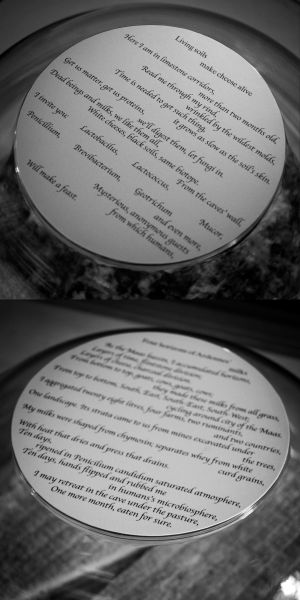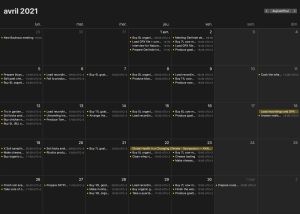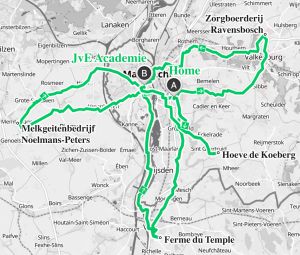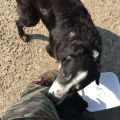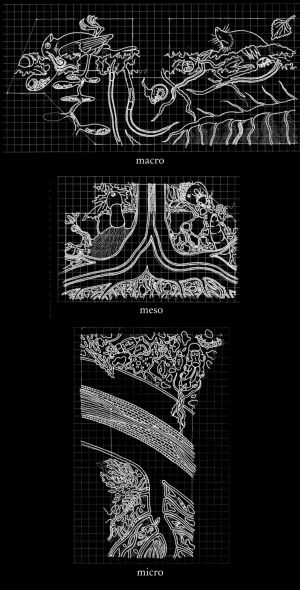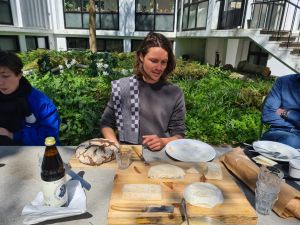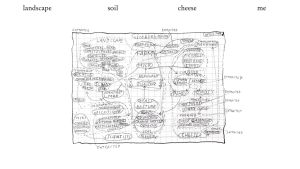Landscape, soil, cheese and me: Difference between revisions
No edit summary |
|||
| (18 intermediate revisions by the same user not shown) | |||
| Line 3: | Line 3: | ||
<br>Robin Bantigny has made and ripened cheeses from locally produced raw milk to share with the residents of the Jan van Eyck Academie. He took pains to record his extensive cycling journeys around the region to dairy farmers, from whom he also collected soil samples to study their biota. These deliberative performative routines entangled him in the landscape’s rhythms of mutualism, growth, and decay. | <br>Robin Bantigny has made and ripened cheeses from locally produced raw milk to share with the residents of the Jan van Eyck Academie. He took pains to record his extensive cycling journeys around the region to dairy farmers, from whom he also collected soil samples to study their biota. These deliberative performative routines entangled him in the landscape’s rhythms of mutualism, growth, and decay. | ||
[[File: | [[File:LandscapeSoilCheeseMe planning.jpg|thumb|Final planning of the full performance.]] | ||
==A 1 month performance== | ==A 1 month performance== | ||
<i>Written at first person as Robin</i> | <i>Written at first person as Robin</i> | ||
<br>During the month of April in the region of Limburg, I entangled myself in a network of beings, mutualism and trophic relationships of decay to produce cheese. By doing so, my ambition was to depict the network in which our primates’ life are tied in when we make food. Moreover, realising our bonds with microscopic beings wether they come from the soil, the cheeses or our guts; was meant to help me experience what makes “us” broader than only-humans. | <br>During the month of April in the region of Limburg, I entangled myself in a network of beings, mutualism and trophic relationships of decay to produce cheese. By doing so, my ambition was to depict the network in which our primates’ life are tied in when we make food. Moreover, realising our bonds with microscopic beings wether they come from the soil, the cheeses or our guts; was meant to help me experience what makes “us” broader than only-humans. | ||
<hr> | <hr> | ||
[[File: | [[File:LandscapeSoilCheeseMe milk-map.jpg|thumb|Map showing where the farms are located compared to Robin’s home and the Academie, including the paths to reach every one of them.]] | ||
===Landscape=== | ===Landscape=== | ||
The landscape was constituted by a space of ±50km² area that I browsed for 30 days. This web of 4 farms brought me to meet 4 Dutch and Belgian farmers. This same landscape provides pastures for their domesticated animals (cows and goats) to graze plants that they digest and transform into the milk that I purchased. On my way to each one of the 4 farms, I described the landscape and recorded myself.<ref>You can listen to excerpts from those recording in the short film [https://www.youtube.com/watch?v=CJC_16hlEq0 Landscape, soil, cheese and me]</ref> While cycling, I tried to describe what makes this landscape: the addition of living beings growing, hunting, socialising and working in the surroundings of the road network from home to farms (fields, buzards, sheds, trees, goose, ponds, crows, etc.) | The landscape was constituted by a space of ±50km² area that I browsed for 30 days. This web of 4 farms brought me to meet 4 Dutch and Belgian farmers. This same landscape provides pastures for their domesticated animals (cows and goats) to graze plants that they digest and transform into the milk that I purchased. On my way to each one of the 4 farms, I described the landscape and recorded myself.<ref>You can listen to excerpts from those recording in the short film [https://www.youtube.com/watch?v=CJC_16hlEq0 Landscape, soil, cheese and me]</ref> While cycling, I tried to describe what makes this landscape: the addition of living beings growing, hunting, socialising and working in the surroundings of the road network from home to farms (fields, buzards, sheds, trees, goose, ponds, crows, etc.) | ||
| Line 36: | Line 36: | ||
File:04-29.jpg| | File:04-29.jpg| | ||
File:04-30.jpg| | File:04-30.jpg| | ||
</gallery> | </gallery> | ||
<hr> | <hr> | ||
[[File: | [[File:LandscapeSoilCheeseMe soil-biota-3-scales.jpg|thumb|3 different scales of observation were used to see as much of the soils’ biota as possible: macro, meso and microscopic.]] | ||
===Soil=== | ===Soil=== | ||
During the last week of April, I extracted a small piece of soil from the pastures of Hoeve de Koeberg, René and Claudia’s organic farm — the farmers I got along with the most. Along the purchased milk, this soil sample was brought back home and “visited” with a microscope to look for living beings in it; thus reflecting on the decomposers’ primal activity to decay and recycle organic matter, the environmental changes threatening this mutualism<ref>I explored this question thanks to an interview of [https://www.wur.nl/fr/Persons/Gerlinde-prof.dr.ir.-GB-Gerlinde-de-Deyn.htm Gerlinde de Deyn], from Wageningen University & Research.</ref>, and its analogy with the way microbe societies make cheeses. | During the last week of April, I extracted a small piece of soil from the pastures of Hoeve de Koeberg, René and Claudia’s organic farm — the farmers I got along with the most. Along the purchased milk, this soil sample was brought back home and “visited” with a microscope to look for living beings in it; thus reflecting on the decomposers’ primal activity to decay and recycle organic matter, the environmental changes threatening this mutualism<ref>I explored this question thanks to an interview of [https://www.wur.nl/fr/Persons/Gerlinde-prof.dr.ir.-GB-Gerlinde-de-Deyn.htm Gerlinde de Deyn], from Wageningen University & Research.</ref>, and its analogy with the way microbe societies make cheeses. | ||
| Line 52: | Line 52: | ||
====Soil’s scales fresco==== | ====Soil’s scales fresco==== | ||
This fresco sits on a very old, worn out wall from the Jan van Eyck Academie’s garden. It was drawn with burnt wood from the garden to depict 3 sizes of the soil’s decomposers: <i>macrofauna</i>, <i>mesofauna</i> and <i>microfauna</i>.<ref>This classification method as well as the depicted beings were directly inspired from | This fresco sits on a very old, worn out wall from the Jan van Eyck Academie’s garden. It was drawn with burnt wood from the garden to depict 3 sizes of the soil’s decomposers: <i>macrofauna</i>, <i>mesofauna</i> and <i>microfauna</i>.<ref>This classification method as well as the depicted beings were directly inspired from [https://www.dropbox.com/s/xeq90fn0ur4q380/JRC_global_soilbio_atlas_online_2_Diversity_LR.pdf?dl=0 Chapter II of The Global Soil Biodiversity Atlas].</ref> Along the wall were exhibited Aliki van der Kruijs’ <i>Soil and sacrement</i>: 2 curtains echoing the 2021 Open Studios exhibition of [[Landscape, soil, cheese and me]]. | ||
<gallery mode="traditional"> | <gallery mode="traditional"> | ||
File:LandscapeSoilCheeseMe_soil-fresco-macro-a.jpg| | File:LandscapeSoilCheeseMe_soil-fresco-macro-a.jpg| | ||
File:LandscapeSoilCheeseMe_soil-fresco-macro-b.jpg| | File:LandscapeSoilCheeseMe_soil-fresco-macro-b.jpg| | ||
File:LandscapeSoilCheeseMe_soil-fresco-meso.jpg| | File:LandscapeSoilCheeseMe_soil-fresco-meso.jpg| | ||
File:LandscapeSoilCheeseMe_exhibition-a.jpg| | File:LandscapeSoilCheeseMe_exhibition-a.jpg| | ||
File:LandscapeSoilCheeseMe_soil-and-sacrement_AlikivanderKruijs.jpg| | |||
</gallery> | </gallery> | ||
<hr> | <hr> | ||
| Line 114: | Line 114: | ||
==A short film== | ==A short film== | ||
[[File: | [[File:LandscapeSoilCheeseMe caption-1.jpg|thumb|The first image of the video is an improvised hand drawn diagram trying to plan the different ties that will form during the 1 month performance.]] | ||
In the start of September 2021, the collective was invited by the [https://janvaneyck.nl/calendar/food-art-film-festival-2021-locality Food Art Film Festival] 2021, run by the Food Lab of the Jan van Eyck Academie, to produce artworks related to <i>localism</i>. This short film was made as a conclusion to [[Landscape, soil, cheese and me]]: | In the start of September 2021, the collective was invited by the [https://janvaneyck.nl/calendar/food-art-film-festival-2021-locality Food Art Film Festival] 2021, run by the Food Lab of the Jan van Eyck Academie, to produce artworks related to <i>localism</i>. This short film was made as a conclusion to [[Landscape, soil, cheese and me]]: | ||
<br> | <br> | ||
*🎞🎥 [https://www.youtube.com/watch?v=CJC_16hlEq0 Landscape, soil, cheese and me] — Short film (~10min) | *🎞🎥 [https://www.youtube.com/watch?v=CJC_16hlEq0 Landscape, soil, cheese and me] — Short film (~10min) | ||
=== | ====Captions from the short film==== | ||
<gallery mode="traditional"> | <gallery mode="traditional"> | ||
File: | File:LandscapeSoilCheeseMe caption-2.jpg| | ||
File: | File:LandscapeSoilCheeseMe caption-3.jpg| | ||
File: | File:LandscapeSoilCheeseMe caption-4.jpg| | ||
File: | File:LandscapeSoilCheeseMe caption-5.jpg| | ||
File: | File:LandscapeSoilCheeseMe caption-6.jpg| | ||
</gallery> | </gallery> | ||
== Take a sneek peak == | |||
<li>🌐 [https://thesoftprotestdigest.org/website/works/landscapesoilcheeseme/ Landscape, soil, cheese and me] — Project page on our showcase website.</li> | |||
==Notes== | ==Notes== | ||
Latest revision as of 18:08, 27 August 2025
Largely confined to the Jan van Eyck Academie during their residency, both Robin and Nickie from The Soft Protest Digest adopted an introspective approach orbiting around questions of transition and self-sustenance in dire circumstances, such as pandemics and planetary crises.
Robin Bantigny has made and ripened cheeses from locally produced raw milk to share with the residents of the Jan van Eyck Academie. He took pains to record his extensive cycling journeys around the region to dairy farmers, from whom he also collected soil samples to study their biota. These deliberative performative routines entangled him in the landscape’s rhythms of mutualism, growth, and decay.
A 1 month performance
Written at first person as Robin
During the month of April in the region of Limburg, I entangled myself in a network of beings, mutualism and trophic relationships of decay to produce cheese. By doing so, my ambition was to depict the network in which our primates’ life are tied in when we make food. Moreover, realising our bonds with microscopic beings wether they come from the soil, the cheeses or our guts; was meant to help me experience what makes “us” broader than only-humans.
Landscape
The landscape was constituted by a space of ±50km² area that I browsed for 30 days. This web of 4 farms brought me to meet 4 Dutch and Belgian farmers. This same landscape provides pastures for their domesticated animals (cows and goats) to graze plants that they digest and transform into the milk that I purchased. On my way to each one of the 4 farms, I described the landscape and recorded myself.[1] While cycling, I tried to describe what makes this landscape: the addition of living beings growing, hunting, socialising and working in the surroundings of the road network from home to farms (fields, buzards, sheds, trees, goose, ponds, crows, etc.)
| Farm name | Location | Milk type | Opening hours | Contact | Price |
|---|---|---|---|---|---|
| Hoeve de Koeberg | Sint Geertruid, NL | organic cow milk | Open from 8 to 8.45 and 18.30 to 19.30 when milking for milk | Claudia +31 655861399 | 1€/L |
| Ferme du Temple | Visé, BE | cow milk | 10-12.30 and 14-16.30, closed Tuesday and Sunday | +32 43797184 | 1€/L |
| Zorgboerderij Ravensbosch | Hulsberg, NL | organic goat milk | Better to come at 9am | Maurice +31 651492391 | 2€/L |
| Melkgeitenbedrijf Noelmans-Peters | Riemst, BE | goat milk | Shop open Wednesday and Saturday 10-17 | José +32 495532390 | 1,5€/L |
Soil
During the last week of April, I extracted a small piece of soil from the pastures of Hoeve de Koeberg, René and Claudia’s organic farm — the farmers I got along with the most. Along the purchased milk, this soil sample was brought back home and “visited” with a microscope to look for living beings in it; thus reflecting on the decomposers’ primal activity to decay and recycle organic matter, the environmental changes threatening this mutualism[2], and its analogy with the way microbe societies make cheeses.
- Soil analysis of milk providers: 1 hectare grassland next to the farm's main barn.
- Trowel sampling: 16 small 10cm deep samples of soil were mixed together. 10 and 20g were extracted and mixed with 100g demineralised water before observation.
- Pitfall trap: one 365mL jar filled with a bit of water was put in the center of the pasture as a trap for small crawling animals to fall in it.
- Baermann funnel: 50g of soil in gauze was attached to the border of a funnel. Demineralised water was poured in to extract microscopic animals from the soil.
Observations: Microscopic fungi and animals, macroscopic insects and worms crawling in samples.
Microscopic observations archives
- 🔬🐾 Check the page dedicated to the soil analysis of Hoeve de Koeberg farm — for more details
Soil’s scales fresco
This fresco sits on a very old, worn out wall from the Jan van Eyck Academie’s garden. It was drawn with burnt wood from the garden to depict 3 sizes of the soil’s decomposers: macrofauna, mesofauna and microfauna.[3] Along the wall were exhibited Aliki van der Kruijs’ Soil and sacrement: 2 curtains echoing the 2021 Open Studios exhibition of Landscape, soil, cheese and me.

Cheese
The cheeses were made 5 days a week with raw goat and/or cow milk from the 4 farms around Maastricht. They were curdled with rennet to make uncooked soft cheeses, that could be pressed too. Half of the cheeses were ripened with various ferments (G. candidum, P. camemberti, P. roqueforti) and the other half developed their own milks’ “wild” microbiota. They were aged for 1 week to 1.5 month in a cold moist room (the Mush-room[5]), without any energy input to control the room’s conditions.
Cheese production archives
- 🧀🌿 Ardennes cheeses in Maastricht — The dedicated page for every cheese made during the performance
- 🧀⛰ Four horizons of Ardennes’ milks — An experiment on designing a cheese that illustrates the local landscape
| G | C | M | o | -# |
|---|---|---|---|---|
| Goat | Cow | Milk | organic | batch number |
Me
👥🧀🥖 All the cheeses made were shared with the artists and staff from the Jan van Eyck Academie.
“Please define yourself, cheese.
—
I am a colony of micro-organisms living on a substrate they feed on.
I am an unpredictable collaboration between domesticated animals and wild microbes that is planned by humans.
I am an extension of human’s digestive system on a food they can barely process.
I am a complex process that preserves various types of fragile milks for weeks if not years.
I am the curdling of proteins and fats of an organic liquid based on water.
I am a convenient shape to store, transport and share nutritious food.
I am a culturally rooted type of processed food that exists in a wide range of periods and places.
I am a set of tastes and sensations that varies from cloudy softness to dirty feet fragrance.
I am farmhouse cheeses, artisanal cheeses, dairy cheeses and industrial cheeses.”
A short film
In the start of September 2021, the collective was invited by the Food Art Film Festival 2021, run by the Food Lab of the Jan van Eyck Academie, to produce artworks related to localism. This short film was made as a conclusion to Landscape, soil, cheese and me:
- 🎞🎥 Landscape, soil, cheese and me — Short film (~10min)
Captions from the short film
Take a sneek peak
Notes
- ↑ You can listen to excerpts from those recording in the short film Landscape, soil, cheese and me
- ↑ I explored this question thanks to an interview of Gerlinde de Deyn, from Wageningen University & Research.
- ↑ This classification method as well as the depicted beings were directly inspired from Chapter II of The Global Soil Biodiversity Atlas.
- ↑ Mauser Open Head Drums found in the garden.
- ↑ Jop Mens built the Mush-room in the Jan van Eyck Academie, in perspective of growing mushrooms in it. Unfortunately, the Covid19 related lockdown made it impossible for him to farm mushrooms. The cool atmosphere and the sealed plastic room constituted the ideal conditions for Robin to ripen cheese on site.
